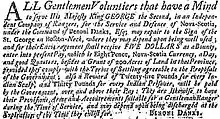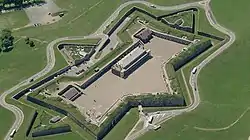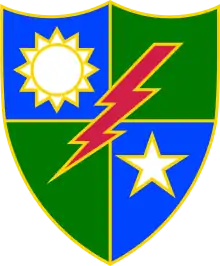Danks' Rangers
Danks' Rangers was a ranger unit raised in colonial North America and led by Captain Benoni Danks (ca. 1716-1776). It was modeled on and often served alongside of the better known Gorham's Rangers.[1] The unit was recruited in early 1756, during the early stages of the Seven Years' War / French and Indian War, from among men serving in two then-disbanding New England provincial battalions stationed in Nova Scotia.[2] Raised to help protect the British garrison on the Isthmus of Chignecto and secure the area after the siege of Fort Beauséjour, their principle foes were Acadians resisting removal from the region and Mi'kmaq Indians resisting British authority. Their primary area of operations was the northwestern portion of Nova Scotia and the north and eastern parts of what would later become New Brunswick. The unit averaged a little over one hundred men for much of its existence, although it seems to have been augmented to 125 for the attack on Havana in 1762.[3] The company often operated in tandem with Gorham's Rangers, based out of Halifax, Nova Scotia, and after 1761, the two companies were combined into a Nova Scotia ranging corps, led by Major Joseph Gorham.
| Danks' Rangers | |
|---|---|
| Active | 1756–1762 |
| Country | |
| Allegiance | British Crown |
| Branch | British Army Ranger |
| Type | Reconnaissance, Counter-insurgency, and Light Infantry |
| Role | Reconnaissance, counter-insurgency, and light infantry operations |
| Size | One Company |
| Garrison/HQ | Fort Cumberland (1756–1762) |
| Engagements | French and Indian War
|
| Commanders | |
| Notable commanders | Captain Benoni Danks |
Composition & Activities

In addition to Yankees from New England, the unit contained Scots and Irish immigrants as well, and a half-dozen Native Americans from New England. The company performed reconnaissance duties and frontier guerrilla warfare. They not only played an important role in the Acadian Removals (1755-1760), but they took part in a number of important campaigns during the war, particularly the landing at Louisburg in 1758, and the Siege of Quebec in 1759. The unit suffered heavy casualties as a result of repeated skirmishing with Canadian militia and allied Indians around the edges of the Quebec siege and, for a time, after Danks was seriously wounded, the unit was absorbed into the ranger company of Captain Moses Hazen. As part of the combined Nova Scotia ranger corps, Danks and his company took part in the Siege of Havana in 1762, where, according to Israel Putnam, Danks sold his commission in the rangers at Havana on 23 Sept. 1762 to Andrew Watson, who commanded the company for the next few months until the unit was disbanded after half its men had succumbed to tropical diseases. The survivors were drafted into British infantry regiments at Havana whose ranks were equally depleted by illness.
Scalping Controversy
The unit was loathed by the Mi'kmaq who lived near Fort Cumberland, the units' main base of operation, and they also suffered from a poor reputation among the early British settlers to the region—apparently because of their reputation for cruelty and for their scalping of enemy combatants and non-combatants alike, regardless of ethnicity. The following account of Danks and his company comes from the notes compiled by Arthur G. Doughty, the editor of the journals of John Knox, an Irish officer in the regulars who was stationed at Fort Cumberland in 1759 and often assigned to accompany Danks' unit on missions:
Doughty says of Danks, "He appears to have been one of the most daring officers in the service, and particularly energetic in attacking the Indians," but goes on to say that the company "were not over scrupulous in the matter of taking scalps." He makes this claim as there is evidence that while they were given (so-called) permission by British authorities to scalp Indians, they were accused of scalping Acadians and Canadians as well. His source for this accusation is a letter written in 1791 by an early Nova Scotia settler, the Rev. Hugh Graham.[4][5] In it, Graham has the following to say about the activities of Danks' company during the dark days of the Expulsion of the Acadians:
- "A Party of the Rangers, a Regiment chiefly employed in scouring the Country of the deluded French who had unfortunately fallen under the Bann of British Policy, came upon 4 French Men, who had with all possible Caution ventur'd out from their Skulking Retreats to pick up some of their straggling Cattle or hidden Treasure. The solitary few, the pitiable four had just sat down, weary & faint, on the Bank [of] a Stream in order to refresh themselves with some Food and Rest, when this Party of the Rangers surprizd & apprehended them. And as there was a Bounty on Indian Scalps (a Blot on Britain's Escutcheon) the Soldiers soon made the supplicating Signal, the Officers turn'd their Backs and the French were instantly shot and scalp'd. A Similar Instance happened about the same time. A Party of the Rangers brought in one day 25 Scalps pretending that they were Indian. And the Commanding Officer at the Fort then Col. Wilmot, afterwards Governor Wilmot (a poor Tool), gave Orders that the Bounty should be paid them. Capt. Houston who had at that time the Charge of the Military Chest objected [to] such Proceedings both in the Letter & Spirit of them. The Col. told him 'That According to Law the French were all out of the French, that the Bounty on Indian scalps was according to Law, and that tho' the Law might in some Instances be strain'd a little yet there was a Necessity for winking at such things.' Upon which Huston in Obedience to Orders paid down, telling them that the Curse of God should ever attend such guilty Deeds."[6]
Doughty further observed that "these Rangers almost without Exception clos'd their days in Wretchedness and particularly a Captain Danks, who ever rode to the Extreme of his Commission in every barbarous Proceeding. In the Cumberland Insurrection [during the American Revolution] he was suspected to be "Jack on both Sides of the Bush" left Cumberland (that place) in a small Jigger bound for Windsor, was taken ill on the Passage, thrown into the hold among the ballast was taken out at Windsor half dead, and had little better than the burial of a Dog. He liv'd under a general Dislike & died without one to regret his Death." [7]
While there is a chance Graham's moralizing account is embellished or merely tall tales told of a more barbaric time, as it was written more than thirty years after the events it discusses by a religious figure, a recent article by historian Brian D. Carroll suggests the Mi'kmaq targeted rangers from Danks' company specifically for violent retribution. And Carroll further quotes Knox himself recording regular British troops having to defend an Acadian woman from members of the company during the Petitcodiac River Campaign in 1758.[8]
Company's Personnel
The sources for the names of the company's personnel below are two muster rolls, one (incomplete) from 1758, and another (complete) from 1761. Both are in the American Antiquarian Society in Worcester Massachusetts (the French and Indian War and Massachusetts Collections, respectively). Another source was a list of sick rangers and deserters from the company in the same collections.
| Part of a series on the |
| Military history of Nova Scotia |
|---|
 |
|
Officers
1758
|
1761-1762
|
Non-Commissioned Officers
Sergeants
|
Corporals
Drummers
|
Anglo-Americans & Other Europeans
|
|
See also
Endnotes
- Carroll, "Savages in the Service," pp. 409-413, 419-425
- Charles Lawrence to Lord Loudoun, Halifax, n.d. [ca. Nov. 6, 1756], Loudoun Papers--North America, Huntington Library, San Marino, Calif.
- Two muster rolls exist for the company, one from 1758 and the other from 1761, housed at the American Antiquarian Society. The breakdown of the company is also contained in numerous returns in the Loudoun and Abercromby Papers (Huntington Library) and in the Amherst Papers (War Office, British Archives)--they show that at full strength the unit had from 100 to 110 men, although due to casualties and illness its numbers ebbed to just 58 at one point.
- Letter by Rev Graham
- While Indians scalped colonists in raids and after battles, they were encouraged to do so by first the British (starting in 1675) and then later by the French colonial government (after 1692). Both eventually fully condoned the practice and encouraged their Indian allies to scalp enemy opponents by paying bounties in cash or trade goods for the grisly trophies. An interesting and important side effect, British Colonial troops adopted the practice but apparently French troops did not, or if they did it was done only rarely. English laws in Massachusetts and other colonies only officially allowed scalping against Native Americans whom they were at war with. However, it is clear these policies openly encouraged genocide, as they paid for the scalps of not just warriors killed in battle but also Native non-combatants. They had a graduated system of bounties that paid the most for a warrior's scalp, less for a woman's and still less for the scalps of Indian children. However Graham's lack of outrage when Indians were scalped by Europeans, yet outrage over Europeans scalping other Europeans smacks of a double standard evident in these statutes and in the attitudes of colonists in general. See James Axtell, "The Unkindest Cut, or Who Invented Scalping," and "Scalping the Ethnohistory of a Moral Question," The European and the Indian, pp. 16-37, 207-243 and Jean-François Lozier, "Lever des chevelures en Nouvelle-France: la politique française du paiement des scalps," Revue d'histoire de l'Amérique française, vol. 56, n° 4, 2003, p. 513-542.
- Nova Scotia Papers, Canadian Archives, M. 651 A. (Brown Collection in British Museum, Add. MSS. 19071).
- Nova Scotia Papers, Canadian Archives, M. 651 A. (Brown Collection in British Museum, Add. MSS. 19071).
- Carroll, "Savages in the Service of Empire," pp. 409-413, 419-425.
- Possibly a Pennsylvanian of Irish descent, born 1734. There was a lieutenant Armstrong in the 2nd Battalion (commanded by George Scott) of the Shirley's provincial forces sent to Nova Scotia in 1755-56. This is probably him.
- Was a provincial officer and later sergeant in the Shirley's provincial battalions. After the Siege of Fort Beausejour in 1755, he helped raise the company of rangers from among the New England men in the regiment (that became Danks' company). He was at the siege of Quebec in 1759. In his 1761 assessment of the officers in his ranging corps, Major Joseph Gorham hoped that Walker could be exchanged for "a more active fit Officer for the Ranging service" as he had become "too corpulent." See "Establishment of Two Companies of Rangers in Nova Scotia," 6 April 1761, Amherst Papers, W.O. 34-12, 74, 86. British Archives.
- Meachum or Meacham in some records. He was probably from Connecticut as in Knox's journal there is a note "One Daniel Meach was appointed Ensign in the 9th Regiment of Colonial troops of Connecticut in 1754." See Colonial Records of Connecticut, X. 313, and Knox, Journals 376. Lt. Meech was killed in action in an ambush in early August 1759 during the siege of Quebec. Perry, Recollections of an Old Soldier (1822), p. 17
- Was about 25 years old in 1761 and had been a provincial officer at the Siege of Fort Beausejour. Afterwards he was appointed to the rangers. He was captured "when on a party" in 1757 with twenty to thirty other rangers and held prisoner for two years in Canada. Amherst Papers, W.O. 34-12, 74, 86. British Archives
- In a 1762 petition, Holland noted he joined the company in 1756. While Gorham declared him well-suited for ranging, Holland resigned his commission just prior to the Havana campaign in the summer of 1762 for several reasons: a serious leg injury he received in 1760, which never healed properly. He declared this rendered him unfit for the service. As a result, he spent from 1760 to 1762 on recruiting duty in New England. He also mentioned that he had suffered numerous financial setbacks because of his lengthy service during the war. Amherst Papers, W.O. 34-12, 86.
- An approximately fifty-year-old Sicilian nobleman and mercenary adventurer. He came to Nova Scotia with Cornwallis in 1750 and appears to have been in the pay of the company since 1759, but had never actually served in the unit before Havana. Gorham described him as lazy and unmotivated and declared him grossly "unfit for the service." Amherst Papers, W.O. 34-12, 86.
- Was a gentleman volunteer in the 40th Regiment and had served at Louisburg and Quebec, before being appointed ensign in the 55th British Regiment of Foot. About aged 18 in 1761, he resigned his commission in the 55th in order to obtain a lieutenancy in the rangers. He cited the recent death of his father and financial circumstances as his motivation for doing so. Amherst Papers, W.O. 34-12, 86.
- Volunteer who was appointed to fill Samuel Shipton's vacancy when he died at Havana. Watmough died shortly thereafter.
- With the company starting at siege of Quebec in 1759. Amherst Papers, W.O. 34-12.
- Probably from Connecticut as he had been in William Lamson's company of the New England provincial battalions sent to Nova Scotia in 1755 prior to enlisting in the rangers.
- Original muster mutilated, rest of name cut off.
- Original mutilated, last name cut off.
- Born circa 1722. Was a member of the 1st New England provincial infantry battalion prior to enlisting in the rangers.
- A veteran of King George's War. Howard Chapin. Rhode Island in the Colonial Wars: A List of Rhode Island Soldiers & Sailors in King George's War 1740-1748 and A List of Rhode Island Soldiers in the Old French & Indian War 1755-1762. (1920; Genealogical Publishing Co. Inc., Baltimore, 1994).
- A veteran provincial soldier of the 1755-1757 campaigns. See Massachusetts Archives 96: 16-18.
- Died shortly after enlisting in the company in 1756.
- Sacowen's name appears on a May 1756 list of 78 men in Captain William Lamson's company in the New England provincial battalions stationed in Nova Scotia, from which men from Danks' Rangers were drawn, along with the names of two dozen other Natives from Connecticut--mostly Mohegan and Tunxis men. In John Winslow's recruiting records for the regiment, Sockiont's place of birth and residence were listed as Groton, in Connecticut, meaning he was almost suredly from the Indian community at Mashantucket. "A List of Souldiers under ye Command of Wmll. Lamson, captaine in a Regiment of foot . . ." Winslow Papers, Massachusetts Historical Society
References
- Carroll, Brian D., ""Savages" in the Service of Empire: Native American Soldiers in Gorham's Rangers, 1744-1762," The New England Quarterly 85, no. 3 (Sept. 2012), pp. 383–429.
- Faragher, Jack Mack, A Great and Noble Scheme: The Tragic Story of the Expulsion of the French Acadians from their American Homeland (W.W. Norton & Co., 2005).
- Grenier, John, The Far Reaches of Empire: War in Nova Scotia, 1710-1760 (Univ. of Oklahoma Press, 2008).
- Plank, Geoffrey, An Unsettled Conquest: The British Campaign Against the Peoples of Acadia (UPENN Press, 2001)

